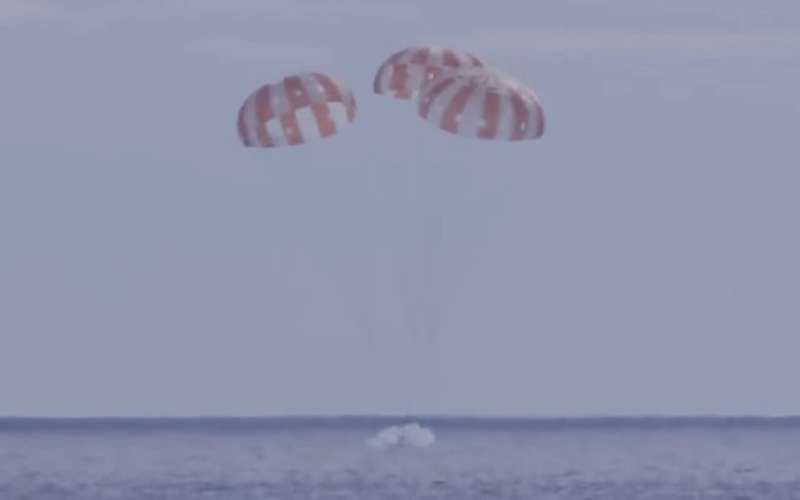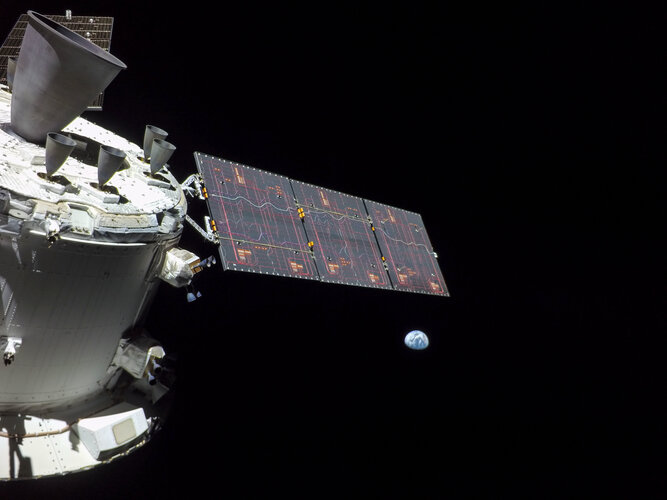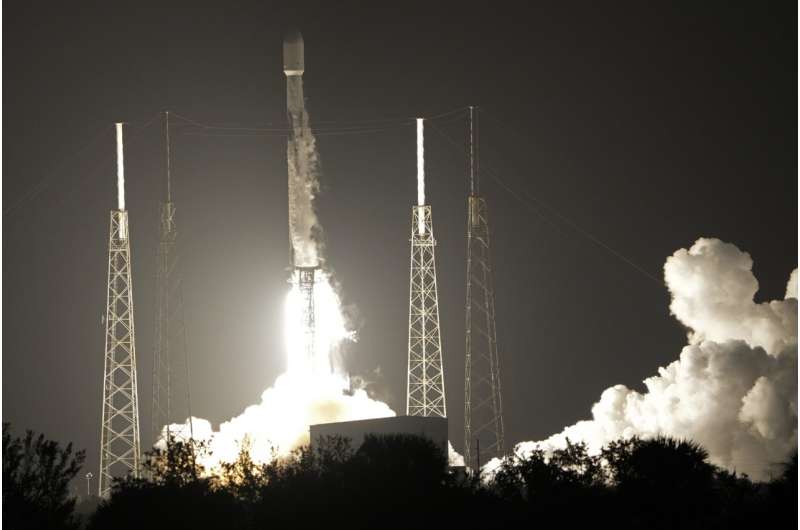
Copernical Team
Monday, 12 December 2022 07:17
NASA capsule Orion splashes down after record-setting lunar voyage
Washington (AFP) Dec 12, 2022
 NASA's Orion space capsule splashed down safely in the Pacific on Sunday, completing the Artemis 1 mission - a more than 25-day journey around the Moon with an eye to returning humans there in just a few years.
After racing through the Earth's atmosphere at a speed of 25,000 miles (40,000 kilometers) per hour, the uncrewed capsule floated down to the sea with the help of three large orange
NASA's Orion space capsule splashed down safely in the Pacific on Sunday, completing the Artemis 1 mission - a more than 25-day journey around the Moon with an eye to returning humans there in just a few years.
After racing through the Earth's atmosphere at a speed of 25,000 miles (40,000 kilometers) per hour, the uncrewed capsule floated down to the sea with the help of three large orange
 NASA's Orion space capsule splashed down safely in the Pacific on Sunday, completing the Artemis 1 mission - a more than 25-day journey around the Moon with an eye to returning humans there in just a few years.
After racing through the Earth's atmosphere at a speed of 25,000 miles (40,000 kilometers) per hour, the uncrewed capsule floated down to the sea with the help of three large orange
NASA's Orion space capsule splashed down safely in the Pacific on Sunday, completing the Artemis 1 mission - a more than 25-day journey around the Moon with an eye to returning humans there in just a few years.
After racing through the Earth's atmosphere at a speed of 25,000 miles (40,000 kilometers) per hour, the uncrewed capsule floated down to the sea with the help of three large orange
Published in
News
Tagged under
Monday, 12 December 2022 00:24
Japanese startup launches historic Moon mission
Washington (AFP) Dec 11, 2022
 A Japanese startup's spacecraft was launched to the Moon on Sunday in the country's first-ever lunar mission and the first of its kind by a private company.
The launch was carried out by Elon Musk's SpaceX at Cape Canaveral in the US state of Florida after two postponements for additional pre-flight checks.
The spacecraft, produced by Tokyo-based startup ispace and carrying a UAE-built r
A Japanese startup's spacecraft was launched to the Moon on Sunday in the country's first-ever lunar mission and the first of its kind by a private company.
The launch was carried out by Elon Musk's SpaceX at Cape Canaveral in the US state of Florida after two postponements for additional pre-flight checks.
The spacecraft, produced by Tokyo-based startup ispace and carrying a UAE-built r
 A Japanese startup's spacecraft was launched to the Moon on Sunday in the country's first-ever lunar mission and the first of its kind by a private company.
The launch was carried out by Elon Musk's SpaceX at Cape Canaveral in the US state of Florida after two postponements for additional pre-flight checks.
The spacecraft, produced by Tokyo-based startup ispace and carrying a UAE-built r
A Japanese startup's spacecraft was launched to the Moon on Sunday in the country's first-ever lunar mission and the first of its kind by a private company.
The launch was carried out by Elon Musk's SpaceX at Cape Canaveral in the US state of Florida after two postponements for additional pre-flight checks.
The spacecraft, produced by Tokyo-based startup ispace and carrying a UAE-built r
Published in
News
Tagged under
Sunday, 11 December 2022 17:25
NASA's Orion capsule blazes home from test flight to moon

NASA's Orion capsule made a blisteringly fast return from the moon Sunday, parachuting into the Pacific off Mexico to conclude a test flight that should clear the way for astronauts on the next lunar flyby.
Published in
News
Tagged under
Sunday, 11 December 2022 18:12
Orion splashes down after record-setting voyage around the Moon
Washington (AFP) Dec 11, 2022
 NASA's Orion space capsule splashed down safely in the Pacific on Sunday, completing the Artemis 1 mission -- a more than 25-day journey around the Moon with an eye to returning humans there in just a few years. After racing through the Earth's atmosphere at a speed of 40,000 kilometers per hour (25,000 mph), the uncrewed capsule floated down to the sea with the help of three large red and white parachutes, as seen on NASA TV.
NASA's Orion space capsule splashed down safely in the Pacific on Sunday, completing the Artemis 1 mission -- a more than 25-day journey around the Moon with an eye to returning humans there in just a few years. After racing through the Earth's atmosphere at a speed of 40,000 kilometers per hour (25,000 mph), the uncrewed capsule floated down to the sea with the help of three large red and white parachutes, as seen on NASA TV.
 NASA's Orion space capsule splashed down safely in the Pacific on Sunday, completing the Artemis 1 mission -- a more than 25-day journey around the Moon with an eye to returning humans there in just a few years. After racing through the Earth's atmosphere at a speed of 40,000 kilometers per hour (25,000 mph), the uncrewed capsule floated down to the sea with the help of three large red and white parachutes, as seen on NASA TV.
NASA's Orion space capsule splashed down safely in the Pacific on Sunday, completing the Artemis 1 mission -- a more than 25-day journey around the Moon with an eye to returning humans there in just a few years. After racing through the Earth's atmosphere at a speed of 40,000 kilometers per hour (25,000 mph), the uncrewed capsule floated down to the sea with the help of three large red and white parachutes, as seen on NASA TV.
Published in
News
Tagged under
Sunday, 11 December 2022 16:51
First Artemis lunar mission ends, so long European Service Module-1

Published in
News
Tagged under
Sunday, 11 December 2022 10:26
Japanese company's lander rockets toward moon with UAE rover

A Tokyo company aimed for the moon with its own private lander Sunday, blasting off atop a SpaceX rocket with the United Arab Emirates' first lunar rover and a toylike robot from Japan that's designed to roll around up there in the gray dust.
It will take nearly five months for the lander and its experiments to reach the moon.
Published in
News
Tagged under
Sunday, 11 December 2022 11:52
NASA's retired SOFIA aircraft finds new home at Arizona Museum
Tucson AZ (SPX) Dec 09, 2022
 NASA's now-retired Stratospheric Observatory for Infrared Astronomy (SOFIA) aircraft will find a permanent home in the Pima Air and Space Museum in Tucson, Arizona. The airplane is expected to make its final flight from NASA's Armstrong Flight Research Center in Palmdale, California, to Tucson on Tuesday, Dec. 13.
"The SOFIA mission has a powerful potential to inspire, from its discoveries
NASA's now-retired Stratospheric Observatory for Infrared Astronomy (SOFIA) aircraft will find a permanent home in the Pima Air and Space Museum in Tucson, Arizona. The airplane is expected to make its final flight from NASA's Armstrong Flight Research Center in Palmdale, California, to Tucson on Tuesday, Dec. 13.
"The SOFIA mission has a powerful potential to inspire, from its discoveries
 NASA's now-retired Stratospheric Observatory for Infrared Astronomy (SOFIA) aircraft will find a permanent home in the Pima Air and Space Museum in Tucson, Arizona. The airplane is expected to make its final flight from NASA's Armstrong Flight Research Center in Palmdale, California, to Tucson on Tuesday, Dec. 13.
"The SOFIA mission has a powerful potential to inspire, from its discoveries
NASA's now-retired Stratospheric Observatory for Infrared Astronomy (SOFIA) aircraft will find a permanent home in the Pima Air and Space Museum in Tucson, Arizona. The airplane is expected to make its final flight from NASA's Armstrong Flight Research Center in Palmdale, California, to Tucson on Tuesday, Dec. 13.
"The SOFIA mission has a powerful potential to inspire, from its discoveries
Published in
News
Tagged under
Sunday, 11 December 2022 11:52
Meteorites plus gamma rays could have given Earth the building blocks for life
Washington DC (SPX) Dec 08, 2022
 Even as detailed images of distant galaxies from the James Webb Space Telescope show us more of the greater universe, scientists still disagree about how life began here on Earth. One hypothesis is that meteorites delivered amino acids - life's building blocks - to our planet.
Now, researchers reporting in ACS Central Science have experimentally shown that amino acids could have formed in
Even as detailed images of distant galaxies from the James Webb Space Telescope show us more of the greater universe, scientists still disagree about how life began here on Earth. One hypothesis is that meteorites delivered amino acids - life's building blocks - to our planet.
Now, researchers reporting in ACS Central Science have experimentally shown that amino acids could have formed in
 Even as detailed images of distant galaxies from the James Webb Space Telescope show us more of the greater universe, scientists still disagree about how life began here on Earth. One hypothesis is that meteorites delivered amino acids - life's building blocks - to our planet.
Now, researchers reporting in ACS Central Science have experimentally shown that amino acids could have formed in
Even as detailed images of distant galaxies from the James Webb Space Telescope show us more of the greater universe, scientists still disagree about how life began here on Earth. One hypothesis is that meteorites delivered amino acids - life's building blocks - to our planet.
Now, researchers reporting in ACS Central Science have experimentally shown that amino acids could have formed in
Published in
News
Tagged under
Sunday, 11 December 2022 11:52
China launches Long March 2D carrier rocket
Beijing (XNA) Dec 09, 2022
 China launched a Long March 2D carrier rocket early on Friday morning to transport an Earth-observation satellite into space, according to the China National Space Administration.
The rocket blasted off at 2:31 am at the Taiyuan Satellite Launch Center in northern China's Shanxi province and soon placed the Hyperspectral Multifunctional Observation Satellite into a sun-synchronous orbit 70
China launched a Long March 2D carrier rocket early on Friday morning to transport an Earth-observation satellite into space, according to the China National Space Administration.
The rocket blasted off at 2:31 am at the Taiyuan Satellite Launch Center in northern China's Shanxi province and soon placed the Hyperspectral Multifunctional Observation Satellite into a sun-synchronous orbit 70
 China launched a Long March 2D carrier rocket early on Friday morning to transport an Earth-observation satellite into space, according to the China National Space Administration.
The rocket blasted off at 2:31 am at the Taiyuan Satellite Launch Center in northern China's Shanxi province and soon placed the Hyperspectral Multifunctional Observation Satellite into a sun-synchronous orbit 70
China launched a Long March 2D carrier rocket early on Friday morning to transport an Earth-observation satellite into space, according to the China National Space Administration.
The rocket blasted off at 2:31 am at the Taiyuan Satellite Launch Center in northern China's Shanxi province and soon placed the Hyperspectral Multifunctional Observation Satellite into a sun-synchronous orbit 70
Published in
News
Tagged under
Sunday, 11 December 2022 11:52
Sol 3676 Another: 'Bore-ing' Day on Mars
Pasadena CA (JPL) Dec 09, 2022
 After yesterday's check-out, Curiosity is GO to attempt to make our 37th drill hole on Mars. The prior plan's DRT cleaned up our target Amapari beautifully - it is in the middle of the clean area in the attached MAHLI image. Today is just a one-sol plan, but it is a full one!
Before drilling, we have a short amount of time for imaging. Drilling take a lot of time and power, so we had to li
After yesterday's check-out, Curiosity is GO to attempt to make our 37th drill hole on Mars. The prior plan's DRT cleaned up our target Amapari beautifully - it is in the middle of the clean area in the attached MAHLI image. Today is just a one-sol plan, but it is a full one!
Before drilling, we have a short amount of time for imaging. Drilling take a lot of time and power, so we had to li
 After yesterday's check-out, Curiosity is GO to attempt to make our 37th drill hole on Mars. The prior plan's DRT cleaned up our target Amapari beautifully - it is in the middle of the clean area in the attached MAHLI image. Today is just a one-sol plan, but it is a full one!
Before drilling, we have a short amount of time for imaging. Drilling take a lot of time and power, so we had to li
After yesterday's check-out, Curiosity is GO to attempt to make our 37th drill hole on Mars. The prior plan's DRT cleaned up our target Amapari beautifully - it is in the middle of the clean area in the attached MAHLI image. Today is just a one-sol plan, but it is a full one!
Before drilling, we have a short amount of time for imaging. Drilling take a lot of time and power, so we had to li
Published in
News
Tagged under
